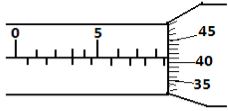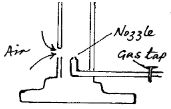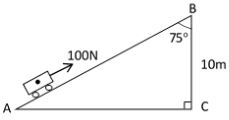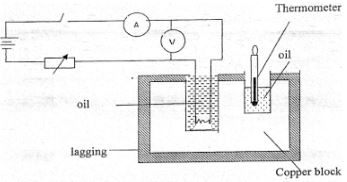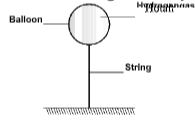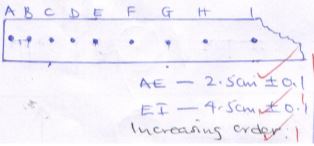Questions
INSTRUCTIONS TO THE CANDIDATE:
- This paper consists of two Sections A and B.
- Answer all the questions in sections A and B in the spaces provided.
- All working must be clearly shown in the spaces provided.
- Mathematical tables and electronic calculators may be used.
SECTION A (25 MARKS) (Answer ALL the questions in the spaces provided)
- What is the reading on the micrometer screw gauge shown below with an error of +0.5mm? (1mk)
- In the study of free fall, it is assumed that the force F acting on a given body of mass, m, is gravitational, given by F = ma. State two other forces that act on the same body (1mk)
- State two facts which show that heat from the sun does not reach the earth surface by convection. (2mks)
- The figure below shows a piece of metal stuck in a hollow glass pipe. .Explain how temperature change may be used to separate them (2mks)
- The water in aburette is 30.6cm3, 50 drops of water each of volume V are added to the water in the burette.The final reading of the burette was 20.6cm3. Calculate theradius of the drop of water. (2mks)
- Inan experiment to demonstrate Brownian motion, smokewas placed in asmoke celland observed under amicroscope. State and explain the observation. (2mks)
- In the figure below, ammonia gas and an acid gas diffuse and react to form a white deposit on the walls of a long glass tube as shown.
- What conclusion can be made from the result of this experiment? (1mk)
- How does the size and mass of a gas affect its rate of diffusion? (1mk)
- The experiment is performed at a lower temperature. Explain how the time taken to form the white deposit would be affected. (1mk)
- Determine the change in momentum produced when a force of 3500N acts on a body which is at rest for 0.002 secomds. (2mks)
- The figure below shows a Bunsen burner. Explain how air is drawn into the burner when the gas tap is opened. (2mks)
- A mass of 100gis hung at the10cm mark and a50gmass at the70cm markof auniform metre rulebalanced at the40cm marks. Determinetheweight ofthe rule. (3 marks)
- Form four students were playing football during which the ball got deflated. Explain what happened to its density (2mks)
- State the branch of physics that deal with kinetic energyof matter. (1mk)
- A student balances a V - shaped uniform wire on a tight string as shown in figure A and B. state with reason the one which is easier to do (2mks)
SECTION B (55 MARKS)
- A student in Lubinu Girls set up an experiment to study the acceleration of a trolley using ticker tape timer. The timer made 50 dots per second on the tape. Dots A to E measured 2.5cm apart and dots E to I measured 4.5cm apart.
- Using a scale drawing show the dots A, B C, D, E, F, G and I as they appeared on the tape.(3mks)
- Determine the velocity of the trolley from:
- A to E. (2mks)
- E to I. (2mks)
- Calculate the acceleration of the trolley. (2mks)
- What end of the tape was fixed onto the trolley? (1mk)
- State two precautions that the student should take before she takes her final samples of the dots. (2mks)
-
- Anastronaut in orbit round the earth mayfeelweightlesseven when the earth’s gravitational field still acts on him. Explain (2mks)
- Distinguish between angularvelocityand linear velocity (1mk)
- A stone is whirled with uniform speed in a horizontal circle ofradius 15 cm. it takes the stone 10 seconds to describe an arcof length 4cm. calculate
- Angularvelocity (3mks)
- Linear velocityof thestone (2mks)
- Periodictime (2mks)
- The figure below shows an inclined plane on which a trolley of mass 30kg is pulled up a slope by a force of 100N, parallel to the slope. The trolley moves so that its centre of mass travels from points A to B.
- Determined the work done on the trolley against the gravitational force in moving from A to B. (2mks)
- Determine the work done by the force in moving the trolley from A to B. (3mks)
- Determine the percentage of the work input that goes to waste (3mks)
- Determine the frictional force. (1mk)
- Determine the mechanical advantage of the system. (1mk)
- Find the velocity ratio (1mk)
-
- The figure below shows a set-up that can be used to determine the specific heat capacity of a metal block.
- Other than temperature and current, state two measurements that should be taken in the experiment to determine the specific heat capacity of the block. (2mks)
- Describe how the method can be used to determine the specific heat capacity of the metal block. (3mks)
- State the purpose of oil in the set-up. (1mk)
- A well lagged copper can together with a copper stirrer of total heat capacity 60JK-1 contains 200g of water at 20°C. Dry steam at 100°C is passed in while the water is stirred until the content reach a temperature of 50°C. Determine the mass of condensed steam. (Specific latent heat of vaporization of water is 2.26 X 106 J/kg and specific heat capacity of water is 4200 J/kgK) (4mks)
- The figure below shows a set-up that can be used to determine the specific heat capacity of a metal block.
-
- State the law of floatation (1mk)
- The diagram below shows ahotair balloon tethered to the ground on a calm day.The balloon contains 1300m3 of hot airof density0.82 kg/m3.The mass ofthe material making the balloon without hot air is 420kg.The density of the surrounding air is 1.35 kg/m3. Determine
- The total weight of hot air balloon (3mks)
- Theweight of air displaced bytheballoon (2mks)
- Upthrust force on the balloon (1mk)
- The tension in theropeholdingthe balloon in theground. (2mks)
- The acceleration with which the balloon begins to raise when released. (3mks)
Marking Scheme
- M.S.R = 8.5 mm✔ Actual reading = 8.96 – 0.5 = 8.46mm✔
S.S.R = (0.01 × 46) = 0.46mm✔
= 8.96mm✔ - Up thrust and frictional force✔
-
- Convection takes place in air upwards direct due to✔1 density deference.
- Convection requires a ✔1 material medium but the space between the sun and the earth i.e. space of the atmosphere has no material medium
- Cool the joint. The metal contract at a higher rate than glass hence the separation.
- 30.6 – 20.6 = 10cm3
Volume of drop of water = 10/ 50 = 0.2cm2
Volume of sphere = 4/3 πr3
0.2 cm3 = 4/3 πr3
r= 0.3627cm - Bright specks are seen to be moving in random motion.The bright specks are smoke particles which are bombarded by the invisible air molecules which are in continuous state of random motion.
-
- Ammonia gas particles diffuse faster than acid gas particles.
- The smaller the size of particles and the smaller the mass, the faster the rate of diffusion.
- It takes longer time because the kinetic energy of particles is reduced i.e particle move at a lower speed.
- Impulse= change in momentum=Ft
= 3.5×1000×0.02=70NS - Gas passes the nozzle at a high speed creating a region of low pressure at A. Atmospheric pressure pushes air in through the hole.
- Sum of clockwise moments = Sum of anticlockwise moments
- 0.3m x 1N = 0.1m x W + 0.3m x 0.5N
- 0.3Nm = 0.15Nm + 0.1W
- 0.15Nm = 0.1W
- W=1.5 N
- The density increases since the volume reduces due to the exit of air.
- Thermodynamics.
- A. In A the c.o.g is lower than the point of support unlike B which is higher.
-
-
-
- Velocity = displacement
time
= 2.5
4 × 0.02✔1
= 31.25cms-1✔1 OR 0.3125ms-1 - E to I
Velocity = 4.5
4 ×0.02✔1
= 56.25 cms-1✔
- Velocity = displacement
- a = u-u
t
= 0.5625 - 0.3125
0.02 ×8
= 0.25/0.16 = 1.5625ms-2 - End A✔1
-
- Trolley runs on a straight path on the runway✔1
- Tape lies flat on the horizontal surface. ✔1
-
-
-
- Gravitational force of attraction between the Astronaut and earth provides centripetal force.
- For the astronaut to move round orbit then gravitational force must be equal to centripetal force.
- Angular velocity is the rate of change of angular displacement while linear velocity is the rate of displacement.
-
- Angular velocity
ώ = Δϴ/ Δt
= (4cm/15cm)/ 10s = 0.2667/10
= 0.02667rad/s - Linear velocity of the stone
v =r ώ
= 0.15 X 0.02667
= 0.004 m/s
OR Δv = ΔS/Δt = 4cm/10s = 0.04m/10s = 0.004m/s - Periodic time
T = 2π/ ώ
= 2π/0.02667
= 235.59 s
- Angular velocity
-
-
- w=mgh
= 30×10×10=3000J - cos 75= 10/AB
AB=38.64m
w=Fd=100×38.64=3864J - Wastage=3864-3000=864J 864/3864 ×100=22.36%
- Wastage=Fr×distance AB
864=Fr×38.64
Fr=22.36J - MA=L/E=300/100=3
- VR= Effort distance =38.64/10=3.864
Load distance
- w=mgh
-
-
-
- Time of heating.
- P.d across the heating coil
- Mass of the copper wire
-
- Determine the mass of the block
- Record the initial temperature
- Put on the switch for some time, t.
- Note the voltmeter and Ammeter reading
- Record the final temperature.
- c=VIt/mθT
- To create thermal contact between the thermometer / heater and block
-
- Heat lost=Heat gained
mLv+mcΔT=Heat capacity×ΔT+McΔT
m×2.26×106+m×4200×50= 60×30+0.2×4200×30
m=0.01093kg or 10.93g
-
-
- A floating body displaces its own weight of the fluid in which it floats.
-
- The total weight of hot air balloon
W= 1300 X 0.82 X 10 + 420 X 10
= 10660 + 4200
= 14860N - The weight of air displaced by the balloon
W = pVg
= 1.35 X1300 X10
= 17550N - Upthrust force on the balloon
Upthrust = weight of air displaced
= 17550N - the tension in the rope holding the balloon in the ground.
T = U – W = 17550 – 14860 = 2690N - The acceleration with which the balloon begins to raise when released.
F = Ma
2690 = 1486 kg X a
a = 1.8102 m/s2
- The total weight of hot air balloon
Download Physics Paper 1 Questions and Answers - ACK Diocese Mumias Joint Evaluation Mock 2022.
Tap Here to Download for 50/-
Get on WhatsApp for 50/-
Why download?
- ✔ To read offline at any time.
- ✔ To Print at your convenience
- ✔ Share Easily with Friends / Students

